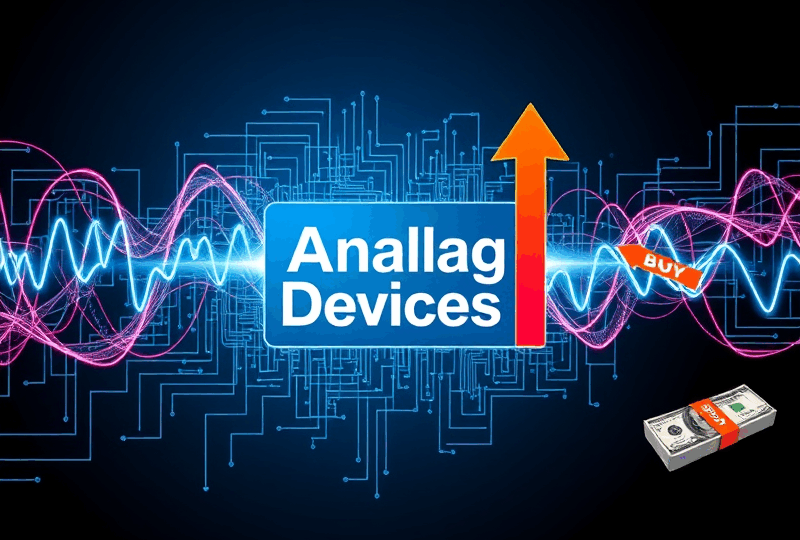
Analog Devices Stock Analysis: Signal Processing Leader’s High-Performance Growth and Dividend Strategy

In the world of electronics, converting and processing real-world signals like sound, light, and pressure into digital information that computers can understand is a fundamental task. Analog Devices (ADI) is a leader in providing high-performance analog, mixed-signal, and digital signal processing (DSP) integrated circuits (ICs). Given its critical role in bridging the physical and digital worlds, you might wonder if Analog Devices stock is a strong buy. Let’s explore what makes ADI a key player in signal processing.
Analog Devices’ Expertise in Signal Processing
Analog Devices specializes in designing and manufacturing chips that perform a wide range of functions related to signal processing. This includes data converters (converting analog signals to digital and vice versa), amplifiers, power management chips, and DSPs. Their products are known for their high performance, precision, and reliability.
These chips are essential components in a vast array of electronic systems across various markets, enabling devices to interact with the real world and process information. ADI’s expertise lies in developing complex ICs that can handle challenging signal processing tasks in demanding applications.
Serving Diverse High-Performance Markets
ADI’s products are used in numerous applications across diverse end markets, with a focus on areas requiring high-performance signal processing. Their largest markets include Industrial (factory automation, instrumentation, medical equipment), Automotive (ADAS, infotainment, electrification), Communications (5G infrastructure, aerospace and defense), and Consumer (high-end audio, portable electronics).
The demand in these markets is often driven by the increasing need for higher performance, greater precision, and more sophisticated sensing and control capabilities. ADI’s focus on providing differentiated, high-value solutions allows them to command strong pricing and margins in these demanding applications.
Financial Performance and Acquisition Strategy
Analyzing Analog Devices’ financials involves looking at revenue growth, particularly across its key end markets. Profitability is strong, reflecting its market leadership in high-performance signal processing and efficient operations. Gross margins are generally high and have been improving.
Operating expenses, especially R&D, are significant as ADI invests heavily in developing new products and technologies to maintain its leadership position. ADI has also grown significantly through strategic acquisitions, notably the acquisition of Linear Technology and Maxim Integrated, which expanded its product portfolio and market reach. Investors are closely watching revenue growth, gross margins, and the successful integration of acquired businesses.
Shareholder Returns: Dividends and Buybacks
Analog Devices has a history of returning value to shareholders through both a growing dividend and share buybacks. They have consistently increased their dividend for many years. Share buybacks are also a significant part of their capital allocation strategy, reflecting strong free cash flow generation.
The company’s ability to fund both R&D investments (crucial for innovation) and shareholder return programs highlights its financial health and the profitability of its high-performance signal processing business. This commitment to returning cash to shareholders is often viewed positively by investors.
Competition and Technological Leadership
Analog Devices operates in competitive semiconductor markets. It competes with other large, diversified semiconductor companies (like Texas Instruments, Infineon, NXP) as well as numerous smaller, specialized vendors in its various product areas. Competition is based on product performance, precision, reliability, breadth of portfolio, technical support, and pricing.
Maintaining technological leadership in high-performance analog and mixed-signal processing is crucial for ADI, as its customers require cutting-edge solutions for their demanding applications. The company invests heavily in R&D to develop new products and platforms that push the boundaries of signal processing capabilities.
Valuation and Investment Considerations
When evaluating Analog Devices stock, investors typically look at the price-to-earnings (P/E) ratio and dividend yield, considering the company’s profitability, growth prospects, and strong shareholder returns. Comparing ADI’s valuation to other large, diversified semiconductor companies focused on similar end markets can provide context. Its valuation often reflects its quality of earnings, market leadership in high-performance niches, and commitment to returning capital.
Considering Analog Devices as an investment involves assessing the long-term demand for high-performance signal processing across its diverse end markets, the company’s ability to maintain its technological leadership and execute its acquisition integration strategy, and the sustainability of its strong free cash flow and shareholder returns. Can ADI continue to be the leader in bridging the physical and digital worlds?
Summary and Final Thoughts
Analog Devices is a leading provider of high-performance analog, mixed-signal, and DSP integrated circuits, playing a critical role in signal processing across diverse markets like Industrial, Automotive, and Communications. The company benefits from its technological leadership, broad product portfolio, and strategic acquisitions. It has a history of strong financial performance and consistently growing its dividend and repurchasing shares.
For investors who believe in the continued and growing need for high-performance signal processing in an increasingly electronic and data-driven world, are confident in Analog Devices’ market leadership and innovation capabilities, and value strong and consistent shareholder returns, the stock could potentially be a strong buy. Its position in essential, high-value niches is a key strength. However, it’s important to be aware of the competitive landscape and the potential impact of economic cycles on its end markets. As always, conducting your own thorough research and considering your personal financial situation and goals are essential before making any investment decisions.






